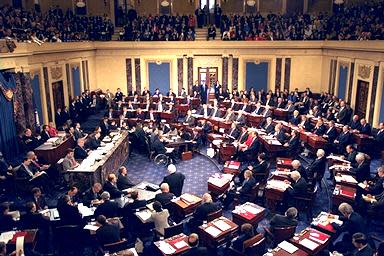What’s in the deal to end the shutdown and extend the debt ceiling
Senate leaders Harry Reid and Mitch McConnell announced an agreement to end the partial federal government shutdown and extend the debt ceiling early on Wednesday afternoon.
Image via Wikimedia Commons.
Assuming the deal can pass votes in the House and Senate, the government could be back in business fully as soon as Thursday. Also, the Treasury Department could resume its borrowing programs on Thursday.
While the proposed deal makes its way through Congress, here are the basics of what made it into the agreement, and what was left out.
1. A continuing resolution funds the government until January 15, 2014. This will allow the government to recall furloughed employees, pay contractors, and reopen museums and national parks—at least until mid-January.
2. The debt ceiling is raised until at least February 7, 2014. The Treasury Department can resume its debt program and can assure global investors that U.S. Treasury instruments are the best safe haven for low-risk investment in the world marketplace.
3. A joint committee will be formed to find a better solution to brinkmanship. The group isn’t being called a supercommittee, but it will be a conference committee of congressional Republicans and Democrats. Their goal is to find a mix of spending and entitlement cuts, and tax reform measures, that can replace the debt-ceiling drama as a way to achieve policy goals in Washington.
4. People enrolled in the Affordable Care Act , or Obamacare, will need verify their income to receive government subsidies under the plan.
5. The Treasury secretary will have the powers to take extraordinary measures to extend the debt ceiling beyond February 7. This was a bargaining point opposed by the GOP, since it makes February 7 a “soft” deadline, which can be pushed back by several months.
6. There won’t be a measure to eliminate the so-called Belly Button Tax. This is $63 per person tax that is part of the ACA that was opposed by unions.
7. The members of Congress, the president, and their staffs will keep government subsidies for their health care.
The next steps in the process will be a decision by congressional leaders about which chamber will take up the vote first. There were reports that the House would vote first on the bill, which would theoretically make it easier to get the bill through the Senate quickly.
Senators Ted Cruz and Mike Lee, key tea party figures, said they won’t oppose bringing the vote to the Senate floor for a full vote.
The Senate was in session late on Tuesday night and will likely need another late session on Wednesday night to finalize a bill for President Obama’s signature.
Recent Constitution Daily Stories
Five things to watch as the debt-ceiling fight comes to a head
How the Supreme Court can resolve the debt ceiling crisis
Interview: The Bipartisan Policy Center’s Shai Akabas on the debt-ceiling dilemma
A few lessons for the current Congress from the First Congress


